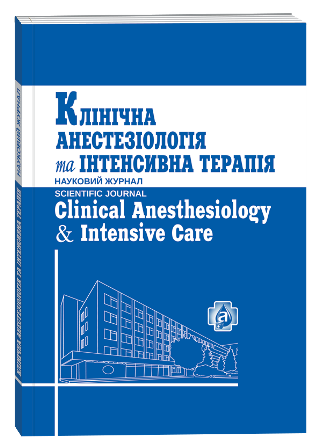FEATURES OF TRACHEAL EXTUBATION IN WOMEN AFTER CESAREAN SECTION
Keywords:
Cesarean section, pre-oxygenation, tracheal extubationAbstract
Relevance. Extubation is one of the most critical and dangerous stages of general anesthesia, because in this period can occur airway obstruction, which may require re-intubation or emergency tracheostomy. Purpose. The goal was to improve the results of anesthetic management of caesarean section by the use of pre-oxygenation before extubation and different tests for predicting uncomplicated extubation. Materials and methods. We analyzed 100 birth stories. The control group (n=50) — preoxygenation was not carried out before tracheal extubation. Extubation was conducted without the use of diagnostic laryngoscopy and the cuff leak test. The main group (n=50) — preoxygenation performed before extubation. Tracheal extubation was performed after the diagnostic direct laryngoscopy and the cuff leak test. Methods of research — clinical, instrumental, laboratory, statistics. Results. For effective forecasting light extubation after severe postoperative period were repeted laryngoscopy and the cuff leak test that prevented the development of serious complications after tracheal extubation. When using prognostic tests, absolute risk reduction was complicated extubation — 0. 78 (95% CI: 0,62–0,87), relative risk — 0.02 (95% CI: 0,12–0,36), decrease relative risk (%) — 0. 80 (95% CI: 0,64-0.89), and the odds ratio — 0.005 (95% CI: 0.0006–0.04). The study found that prior to extubation of the trachea must take into account the data of diagnostic direct laryngoscopy, the cuff leak test, decrease effects of traumatic edema of the larynx, as well as the time since the end of the operation. The use of pre-oxygenation can significantly increase the oxygen reserve and as a result improve patient safety after extubation. Conclusions. Thus, pre-oxygenation is a necessary component to tracheal extubation after the anesthetic management of caesarean section. The diagnostic direct laryngoscopy and the cuff leak test before tracheal extubation reliably predicts uncomplicated tracheal extubation.
References
Ramkumar V. Preoxygenation with 20° headup tilt provides longer duration of nonhypoxic apnea than conventional preoxygenation in non-obese healthy adults / V. Ramkumar, G. Umesh, F. A. Philip // J Anesth. – 2011. – Vol. 25. – P. 189–194.
Karmarkar S. Tracheal extubation / S. Karmarkar, S. Varshney // Critical Care and Pain. – 2008. – Vol. 8 – P. 214–220.
Obstetric Anaesthetists Association and Difficult Society guidelines for the management of difficult and failed tracheal intubation in obstetrics / M. C. Mushambi, S. M. Kinsella, M. Popat [et al.] //Anaesthesia. – 2015. – Vol. 70. – P. 1286–1301.
Russell E. C. Preoxygenation in pregnancy: the effect of fresh gas flow rates within a circle breathing system / E. C. Russell, I. Wrench, F. Meast, F. Mohammed // Anaesthesia. – 2008. – Vol. 63. – P. 833–836.
The difficult airway with recommendations for management. Part 1. The anticipated difficult airway / J. A. Law, N. Broemling, R. M. Cooper [et al.] // Canadian Journal of Anesthesia. – 2013. – Vol. 60. – P. 1119–1138.
Sukhupanyarak S. Risk factors evaluation and the cuff leak test as predictors for postextubation stridor / S. Sukhupanyarak // J Med Assoc Thai. – 2008. – № 91 (5). – P. 648–653.







